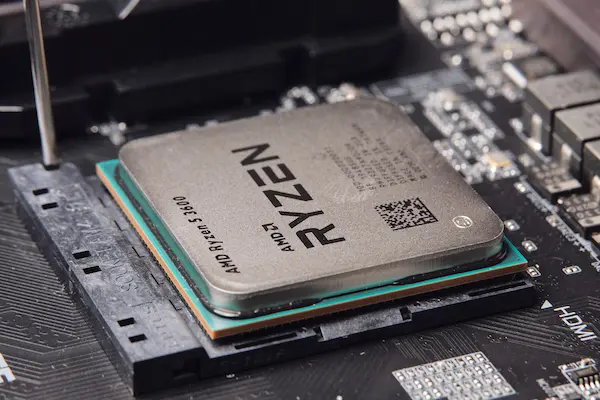AMD has a unique way of naming its processors. Today, we’ll break down the AMD Ryzen CPU names and what each letter means.
While there are numerous AMD processors available, we’re honing in on the Ryzen family, widely used in desktops and laptops.
This article serves as a user-friendly guide to help you understand the AMD naming system, providing clear explanations for the numbers and letters associated with Ryzen processors.
Table of Contents
Decoding AMD Ryzen Series Names
Much like the commonly encountered Intel Core i-series processors in laptops, AMD Ryzen processors are their equivalent counterparts, offering a range of options tailored to diverse computing needs.
Here’s a simplified breakdown:
AMD Ryzen 3:
- Positioned as the entry-level processor in the Ryzen family.
- Similar to Intel Core i3 in performance but comes at a more budget-friendly price.
- Capable of handling everyday computing tasks and some moderate-intensive activities.
- Quad-core processors provide ample processing power.
AMD Ryzen 5:
- Falls into the mid-range category within the Ryzen family.
- Available as either hexa-core processors or quad-core.
- Exhibits higher clock speeds compared to Ryzen 3, enabling it to tackle more demanding tasks.
- Direct competition for Intel Core i5 processors.
AMD Ryzen 7:
- Positioned as a high-performance processor.
- Comes in hexa-core, quad-core, or octa-core configurations.
- Well-suited for handling intensive computing tasks, surpassing the capabilities of Ryzen 5 and 3 processors.
- Competes directly with Intel Core i7 processors.
AMD Ryzen 9:
- The pinnacle of power within the Ryzen family.
- Boasts the highest clock speeds and core count.
- Direct competition for Intel Core i9, excelling in handling extremely intensive applications that leverage multi-core processing and computing tasks.
AMD Ryzen Threadrippers:
- Specialized high-performance multi-core processors.
- Designed for desktops rather than laptops.
- Tailored to manage extensive multitasking and applications requiring advanced hyperthreading for smooth operation.
Decoding AMD Ryzen Processor Letters and Numbers
Understanding the nuances of AMD Ryzen processor names involves deciphering both letters and numbers to gauge their performance and capabilities. Here’s a breakdown for clarity:
Letter Suffixes:
“G” Suffix:
- Indicates the presence of a Radeon graphics card.
- Similar to Intel Core i-series with “G,” featuring AMD Radeon RX Vega graphics.
“X” Suffix:
- Signifies high performance.
- Ryzen processors with “X” have the highest clock speeds, power consumption, and top-notch performance.
- Desktop processors featuring Extended Frequency Range (XFR), allowing performance boosts beyond standard limits.
“U” Suffix:
- Represents ultra-low power for thin and light laptops.
- Lower clock speeds, reduced power consumption, and minimized heat production.
- Ideal for thin laptops with limited thermal dissipation.
“H” Suffix:
- Denotes high-performance.
- Ryzen processors with “H” have higher power consumption and clock speeds, resulting in superior performance.
- Typically found in larger laptops with better cooling systems.
“T” Suffix:
- Indicates turbo or higher clock speeds.
- For instance, “XT” signifies boosted clock speeds and improved performance compared to variants without the “T.”
No Letter Suffix:
- Designates desktop processors without additional features.
Number Meanings:
Breaking down the numbers in an AMD Ryzen processor name, let’s use “AMD Ryzen 5 2600X” as an example:
“5” in 2600X:
- Represents the generation of the processor (in this case, 5th Generation).
- Higher generations generally indicate improved performance compared to predecessors.
“6” in 2600X:
- Indicates the performance level.
- Numbers 5, 4, and 6 represent high-performance processors, while 7 and 8 cater to enthusiasts and prosumers involved in tasks like video editing and CAD works.
“00” in 2600X:
- Represents Stock Keeping Unit (SKU) or the model number.
“X” Suffix in 2600X:
- Confirms high-performance capabilities and features like Extended Frequency Range (XFR) for performance boosts beyond standard limits.
Deciphering AMD Processor Generation on Windows Devices
If you’re using a laptop or desktop powered by AMD, determining the processor’s generation is straightforward. Here’s a quick guide for Windows users:
- Press the Windows + R buttons to open the RUN dialog.
- Type “dxdiag” and click OPEN.
- In the dxdiag dialog box under the SYSTEM tab, locate the processor information.
- Identify the processor and its generation. For example, if it’s an AMD Ryzen 7 4700U processor, the “2” in 4700U indicates it’s a 4th-generation processor.
In conclusion, understanding the numbers and letters associated with AMD Ryzen processors equips you with the knowledge to assess if your AMD-powered laptop meets your computing requirements. This knowledge empowers you to determine the performance capabilities of your device, ensuring it aligns with your needs. That concludes the essentials of the AMD naming scheme.







